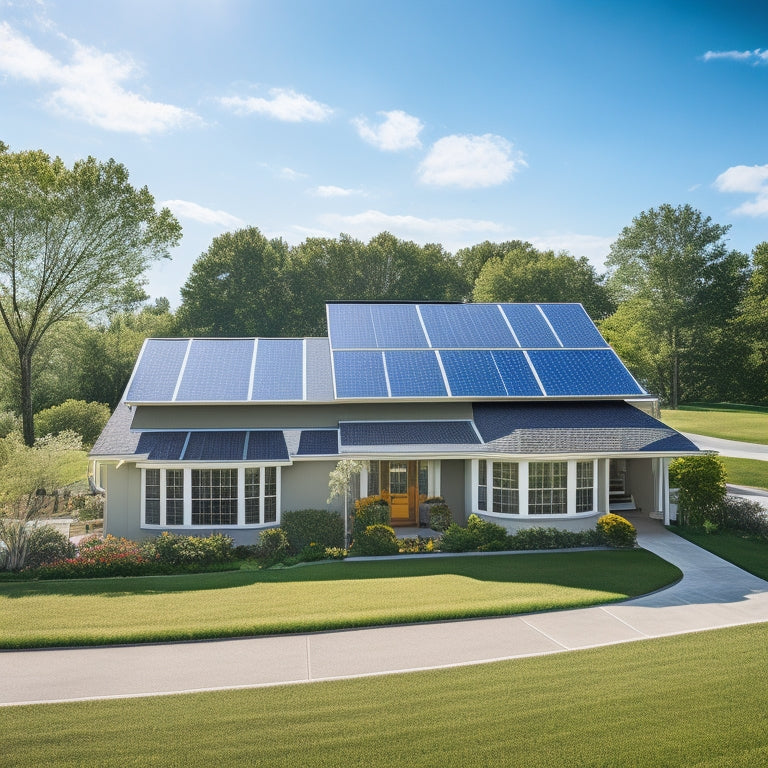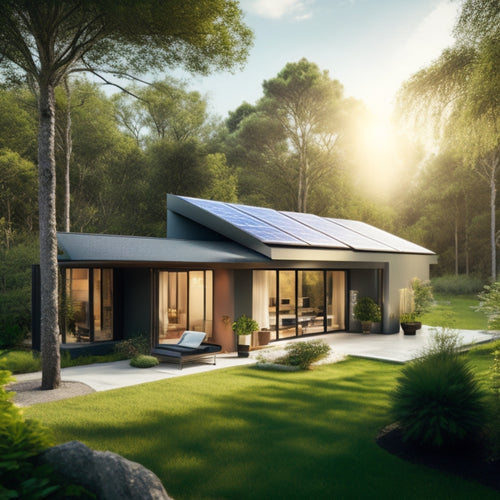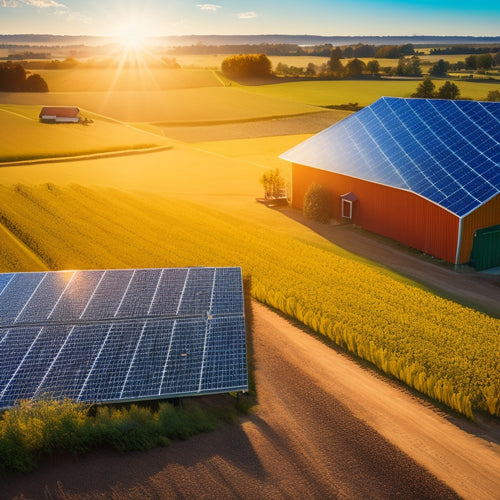
What to Consider When Installing Solar Panels in Your Area
Share
When installing solar panels in your area, you'll need to take into account several key factors. Start by researching local building codes and regulations, as compliance is vital for a successful installation. Assess your roof's size, condition, and orientation, as well as potential shading and obstruction factors. Evaluate your daily energy consumption patterns and peak sun hours to determine the required system size. You'll also want to investigate financing options, panel types, and installation companies. Additionally, take into account weather and climate conditions, as well as environmental impact. By understanding these essential aspects, you'll be well on your way to a successful and efficient solar panel installation that meets your energy needs.
Key Takeaways
- Determine local building codes and permits required to ensure compliance with safety standards and electrical codes.
- Assess your roof's size, condition, and orientation to determine the optimal solar panel configuration and potential electricity generation.
- Evaluate daily energy consumption patterns to size the solar panel system correctly and maximize energy production.
- Research local incentives, tax credits, and financing options to reduce installation costs and improve return on investment.
- Consider the impact of local weather and climate conditions, such as shading, temperature, and humidity, on solar panel performance.
Local Building Codes and Regulations
How much do local building codes and regulations impact your decision to install solar panels? The answer: considerably. Before installing solar panels, you must comply with local zoning restrictions, which dictate the size and location of your solar array.
You'll also need to obtain necessary permits, confirming your installation meets safety standards and electrical codes. Local inspectors will verify that your solar panel system adheres to installation guidelines, assuring structural integrity and minimizing environmental impact.
Additionally, you'll need to contemplate local building codes, which vary by region. These codes regulate aspects like roof-mounted solar panel installation, electrical connections, and system grounding.
Failure to comply can result in costly rework, fines, or even system shutdown. To avoid these issues, familiarize yourself with local regulations and consult with a licensed solar installer who's well-versed in local codes and permit requirements.
Roof Size and Condition
Your roof's size and condition play an essential role in determining the suitability of your home for solar panels. The size of your roof will impact the number of solar panels you can install, and subsequently, the amount of electricity you can generate. A larger roof provides more space for panels, allowing you to generate more power.
However, if your roof is too small, you may need to think about more efficient panels or a different installation configuration.
The condition of your roof is also significant. A roof in disrepair may not be able to support the weight of solar panels, and you may need to invest in repairs or even replacement before installation.
Additionally, the orientation and angle of your roof affect the performance of your solar panels. A south-facing roof with an installation angle between 30-40 degrees is ideal, as it allows for maximum energy production.
If your roof doesn't meet these conditions, you may need to adjust the installation angle or think about a different mounting system to optimize energy output.
Shading and Obstruction Factors
When you're evaluating your roof's suitability for solar panels, you'll need to take into account the impact of shading and obstructions on energy production.
You'll want to assess how tree coverage will affect your system's performance, as well as the shadow effect of nearby buildings.
Additionally, you'll need to analyze any obstructions on your roof, such as vents or skylights, to guarantee they won't hinder your solar panels' ability to generate power.
Tree Coverage Impact
Shadows cast by trees can greatly impact the performance of your solar panel system. As you consider installing solar panels, it's crucial to assess the tree coverage in your area.
Different tree species have varying levels of foliage density, which affect the amount of shade they cast. For instance, deciduous trees like oak and maple provide more shade during summer months when they're in full leaf, while evergreen trees like pine and spruce cast a more consistent shadow year-round.
Seasonal changes also play a significant role in tree coverage impact. During winter, trees with bare branches may allow more sunlight to reach your solar panels, but in the summer, their leafy canopies can block a substantial amount of sunlight.
To mitigate this effect, you may need to trim or remove trees that cast significant shadows on your solar panel system. Be sure to consult with a professional to determine the best course of action for your specific situation.
Building Shadow Effect
Beyond tree coverage, building shadows can also significantly impact your solar panel system's performance. The height and proximity of surrounding buildings can cast shadows on your solar panels, reducing their energy output. To alleviate this effect, it's vital to take into account the building shadow effect during the installation process.
| Building Height | Shadow Impact |
|---|---|
| Low-rise (< 3 stories) | Minimal shadow impact, ideal for south-facing solar panels |
| Mid-rise (3-6 stories) | Moderate shadow impact, consider adjusting solar panel orientation |
| High-rise (> 6 stories) | Significant shadow impact, require careful solar panel placement |
The building height impact is important, as taller buildings can cast longer shadows, affecting your solar panel system's performance. Additionally, the solar panel orientation plays a significant role in minimizing the shadow effect. By understanding the building shadow effect, you can optimize your solar panel system's design to maximize energy production. By doing so, you'll be able to utilize the power of the sun more efficiently, reducing your reliance on traditional energy sources.
Roof Obstruction Analysis
Most rooftops have some degree of obstruction that can impact solar panel performance. When conducting a roof obstruction analysis, you'll want to identify any shading or obstruction factors that could affect your solar panel system's energy output. This includes evaluating the presence of skylights, vents, chimneys, and other roof features that could cast shadows or block sunlight.
You'll also need to reflect on the solar panel orientation and how it relates to potential obstructions. For example, if you have a south-facing roof with a large tree nearby, you may need to adjust the panel orientation or trim the tree to minimize shading.
Additionally, take into account the installation timeframe and how seasonal changes may impact shading patterns. For instance, if you're installing solar panels in the winter, you'll want to account for the longer shadows cast by surrounding objects during this time.
Energy Efficiency and Usage
You'll need to assess your daily energy consumption to determine the size of the solar panel system required to meet your needs.
This involves calculating your energy usage in watt-hours (Wh) and identifying the peak sun hours (PSH) available at your location.
Daily Energy Consumption
Your home's daily energy consumption pattern plays a significant role in determining the size and number of solar panels required to meet your energy needs.
To accurately assess your energy requirements, you need to understand your energy habits and consumption patterns. Start by tracking your energy usage over a period of time to identify the times of day when you use the most energy. This will help you determine the total kilowatt-hours (kWh) of electricity your home consumes daily.
You can analyze your past utility bills to get an idea of your average daily energy consumption. Look for patterns, such as peak usage during morning and evening hours when lights, appliances, and electronics are in use.
You may also want to contemplate the energy efficiency of your appliances and lighting systems. By understanding your daily energy consumption, you can determine the correct size of the solar panel system needed to meet your energy needs, ensuring you generate enough power to cover your usage.
This information will also help you identify areas where you can make adjustments to reduce your energy consumption and optimize your solar panel system's performance.
Peak Sun Hours
How much energy can your solar panel system realistically produce? Peak sun hours play an essential role in determining your system's energy production. Peak sun hours refer to the amount of solar exposure your location receives during the day. This metric is vital in evaluating your system's energy production potential.
-
Your location's peak sun hours vary depending on factors such as latitude, altitude, and time of year.
-
Areas with high peak sun hours receive more direct sunlight, resulting in increased energy production.
-
Peak sun hours can range from 4-6 hours in areas with moderate solar exposure to 7-8 hours in areas with high solar exposure.
Understanding peak sun hours helps you assess your system's energy production capabilities and optimize its performance.
Cost and Financing Options
Frequently, homeowners considering solar panel installation are deterred by the upfront costs, which can be substantial. However, with a thorough cost analysis, you can investigate various financing options to make your solar dreams a reality.
| Financing Option | Benefits | Considerations |
|---|---|---|
| Cash Purchase | No interest rates or loan fees | High upfront cost |
| Loan Financing | Fixed monthly payments, tax benefits | Interest rates, loan fees |
| Power Purchase Agreement (PPA) | No upfront cost, fixed energy rates | Lock-in period, limited customization |
When evaluating financing options, consider your budget, credit score, and energy savings goals. You may also want to investigate local and national incentives, such as tax credits or rebates, to offset the initial cost. A thorough cost analysis will help you determine the most cost-effective solution for your solar panel installation. By understanding the costs and financing options, you can make an informed decision and start utilizing the power of the sun.
Panel Type and Quality
Once you've secured a financing option, it's time to focus on the heart of your solar panel system: the panels themselves.
When it comes to panel type and quality, you'll want to take into account factors that impact performance and longevity.
Panel efficiency is a vital consideration, as it determines how much power your system can generate. Look for high-efficiency panels with a rating of 20% or higher.
Additionally, material durability is essential, as your panels will be exposed to the elements for decades. Verify your panels are built with durable materials that can withstand extreme temperatures, humidity, and weather conditions.
When evaluating panel quality, keep the following in mind:
- Monocrystalline silicon panels offer high efficiency and durability
- Polycrystalline silicon panels provide a balance of efficiency and affordability
- Thin-film panels are a cost-effective option, but may have lower efficiency
- Certifications like UL and IEC guarantee compliance with industry standards
Installation Company and Warranty
You've narrowed down your panel options, now it's essential to find a reliable installation company to guarantee your system is installed correctly. A reputable company will have extensive installation experience, making certain that your solar panel system is set up to maximize energy production.
Look for companies with a proven track record of successful installations and ask about their installation process, including the quality of their equipment and the training of their technicians.
When evaluating installation companies, pay close attention to their warranty coverage. A thorough warranty should cover both the panels and the installation work. Check the length of the warranty, what's included, and what's excluded.
A good warranty should provide peace of mind, protecting your investment in case anything goes wrong. Be wary of companies with limited or no warranty coverage, as this may indicate a lack of confidence in their work.
Maintenance and Repair Needs
As you've secured a reliable installation company with an extensive warranty, it's time to evaluate the ongoing maintenance and repair needs of your solar panel system.
Regular maintenance is essential to guarantee your system operates at peak performance. You'll need to establish cleaning schedules to remove dirt, debris, and snow that can reduce energy output.
Additionally, you should inspect your system regularly for signs of wear and tear, such as loose connections or damaged components.
Here are some key aspects to reflect on:
-
Component lifespan: Understand the average lifespan of each component, including panels, inverters, and mounting hardware, to plan for future replacements.
-
Scheduled maintenance: Develop a routine maintenance schedule to guarantee timely inspections and repairs.
-
Repair costs: Factor in potential repair costs and think about setting aside a budget for unexpected expenses.
- Monitoring system performance: Keep track of your system's energy output to identify potential issues early on.
Weather and Climate Conditions
When installing solar panels, you'll need to take into account the local weather and climate conditions, as they can greatly impact the performance and longevity of your system.
Extreme temperature fluctuations, for instance, can affect the panels' efficiency, while high humidity and moisture levels can lead to corrosion and other issues.
You'll want to assess these factors to guarantee your solar panel system is designed and installed to withstand the unique challenges of your region.
Extreme Temperature Fluctuations
Across various regions, solar panels are exposed to extreme temperature fluctuations that greatly impact their performance and durability. As you consider installing solar panels, you need to understand how temperature extremes will affect your system's energy output and lifespan. High temperatures can reduce energy production, while low temperatures can increase it. However, if the temperature drops too low, the panels may not produce energy at all.
When installing solar panels, keep in mind the following key considerations:
-
Insulation impact: Proper insulation can help reduce heat gain during summer and heat loss during winter, minimizing the impact of temperature fluctuations on your system's performance.
-
Energy storage: Consider investing in energy storage solutions to store excess energy generated during periods of high production, ensuring a stable power supply during periods of low production.
-
Panel longevity: Temperature extremes can affect the lifespan of your solar panels. Look for panels with high temperature tolerance and consider installing them at an angle to allow for natural cooling.
- Installation timing and performance monitoring: Installing your solar panels during the cooler months can help reduce the impact of temperature extremes. Regular performance monitoring will also help you identify any issues and optimize your system's energy output.
Humidity and Moisture Levels
Humidity and moisture levels greatly impact the performance and longevity of your solar panels. High humidity and moisture can lead to corrosion, reducing your system's efficiency and lifespan. When selecting solar panels, look for those with high corrosion resistance and effective moisture management systems.
| Environment | Humidity Level | Impact on Solar Panels |
|---|---|---|
| Coastal | High (60-80%) | High risk of corrosion, saltwater damage |
| Tropical | High (70-90%) | Increased risk of corrosion, panel degradation |
| Desert | Low (20-40%) | Low risk of corrosion, ideal performance |
| Urban | Moderate (40-60%) | Moderate risk of corrosion, average performance |
When installing solar panels in humid or coastal areas, consider taking extra precautions to guarantee their longevity. This may include using specialized mounting systems, applying corrosion-resistant coatings, or incorporating drainage systems to manage moisture. By understanding the humidity and moisture levels in your area, you can take steps to protect your investment and maximize your solar panel's performance.
Incentives and Tax Credits
In the process of switching to solar energy, you'll likely be pleased to find that various incentives and tax credits are available to help offset the upfront costs of installation.
These financial benefits can greatly reduce the overall cost of going solar, making it a more accessible and affordable option for homeowners.
Some of the incentives you may be eligible for include:
-
Federal incentives: The Solar Investment Tax Credit (ITC) allows you to claim a credit of 26% of the total cost of your solar panel system.
-
State tax credits: Many states offer additional tax credits, which can vary in amount and eligibility requirements.
-
Local rebates: Municipalities and utilities may offer rebates or discounts on solar panel installations.
- Financing options: Specialized financing programs and loans can help spread the cost of installation over time.
Frequently Asked Questions
Can I Install Solar Panels on a Metal or Tile Roof?
You can install solar panels on a metal roof, considering the type of metal and its condition, but you'll need to guarantee a secure attachment method. For tile roofs, you'll need to assess compatibility with the tile type and guarantee proper flashing to prevent water damage.
Will Solar Panels Affect My Home's Resale Value?
Imagine a 'for sale' sign on your lawn, attracting eco-conscious buyers like bees to honey. You'll find that solar panels enhance your home's resale worth by up to 17%, thanks to the long-term solar panel benefits, making your property more desirable and precious.
Can I Install Solar Panels on a Rented Property?
You'll need to review your rental agreements and obtain your landlord's explicit permission before installing solar panels on a rented property, as modifications typically require approval and may impact your lease terms.
Do Solar Panels Work During a Power Outage?
You'll find that solar panels don't provide power during an outage unless you have a battery backup system, which enhances grid independence. During an outage, your solar panel efficiency is wasted without a storage solution to utilize the energy.
Can I Expand My Solar Panel System in the Future?
Did you know that 90% of solar panels still operate at 80% capacity after 25 years? You can easily expand your system in the future by checking your current setup's compatibility and ensuring future capacity isn't limited by your existing infrastructure.
Conclusion
As you consider installing solar panels, remember that a million tiny details can make or break the success of your project. From local building codes to weather and climate conditions, every factor is essential. Weigh each consideration carefully, and you'll be utilizing the power of the sun like a pro. By doing your due diligence, you'll be basking in the glow of renewable energy - and the savings it brings - for years to come.
Related Posts
-

Top-Rated Solar Storage Solutions for Homeowners
When considering top-rated solar storage solutions, you're looking at systems that provide energy independence and si...
-

Off-Grid Solar Solutions for Sustainable Farming
Off-grid solar solutions can revolutionize your farming operations by providing energy independence and significant c...
-

Solar Inverter Troubleshooting for Beginners
Troubleshooting your solar inverter starts with understanding its efficiency and performance metrics. Check for prope...


